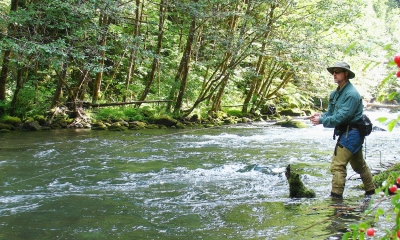
Bass
Oregon offers great bass fishing throughout the state. Whether you're after smallmouth, largemouth or hybrids, there's a place nearby to catch a bass.

Types of Bass

Features: These fish are light silvery-white, dark on top, and have up to 8 dark, broken stripes running along the sides of their bodies. They are typically less than 10 lbs but can grow to 22 lbs. They have two dorsal fins, the front one with eight or nine spines and the rear one with one spine and 13 or 14 soft rays.
Habitat: Hybrid bass were originally stocked in Tenmile Lakes on the south coast and in Ana Reservoir in Lake County. They have since been introduced into Thompson Reservoir, also in Lake County. The only established population is in Ana Reservoir. Juvenile hybrid bass spend their first year near shore where they feed on zooplankton and insect larvae. However, by the time they are one-year old most have moved offshore to open water and switched almost totally to a fish diet. Because of their size and diet of fish, hybrid bass can be effective at controlling populations of forage fish, such as the tui chub in Ana Reservoir. Hybrid bass do not reproduce, so their continued presence depends on periodic stocking.
Technique: At Ana Reservoir, fish for hybrid bass early in the year in the deeper water along the west side of the lake. The temperature of the reservoir is moderated by a large deep-water inflow of constant-temperature springwater so that hybrids feed actively and can be caught throughout the winter. During spring and fall, find hybrid bass off shore over deeper water, but actively feeding in the top 5 to 15 feet. As surface temperatures increase in the summer, hybrids move deeper into cooler water. Hybrid bass may be caught by still-fishing near the bottom using sand shrimp, prawns, worms or chicken livers for bait, or by trolling lures or plugs that imitate small fish.

Features: Largemouth bass are greenish on the back and sides with a white belly and usually a dark horizontal stripe along the side. They are distinguished from their close cousin, the smallmouth, by a large mouth with the upper jaw extending behind the eye. Largemouth bass in Oregon can exceed 25 inches in length and a weight of 12 pounds.
Habitats: Their preferred habitats are shallow ponds and lakes, or the backwater sloughs of rivers where aquatic plants or submerged logs and brush provide abundant cover. Largemouth bass begin life feeding on zooplankton (tiny crustaceans), but soon switch to insects, and then to fish and crayfish.
Technique: Largemouth bass may be caught most of the year, but are difficult to catch when the water temperature is less than 50°F. Early in the spring try nightcrawlers, plastic worms or jigs fished slowly along the bottom around cut banks, channels, rock piles and woody cover. Bass move into shallow water to spawn when the water temperature nears 60°F. As the water warms, largemouth will strike surface (e.g., popper, propeller type bait or darter) or shallow running lures fished around weed beds, docks, pilings, sunken logs, weed lines, and other shoreline cover. The best time to fish surface lures is early or late in the day or at night, and when the water surface is calm. During the hot part of the summer, largemouth seek deeper, cooler water during the bright part of the day where they may be taken on lead-head jigs, plastic worms and deep running plugs. Use pauses and short jerks of the rod tip to give the lure action. When fishing with diving plugs, use a steady retrieve, with speed determining depth of return. Underwater plugs such as crankbaits and spinnerbaits also work well when the water is rough or choppy.

Features: Smallmouth bass are golden green to bronze with dark vertical bars and blotches on the side. The upper jaw does not extend beyond the eye. In some locations, it has a red eye. Somewhat smaller than the largemouth, smallmouth bass in Oregon may reach 23-inches and exceed 7 pounds.
Habitat: Smallmouth bass are adapted to flowing waters and do well in warm streams with deep holes and rocky ledges. They also prefer lakes and reservoirs with rocky shorelines and limited vegetation. Adult smallmouth feed mostly on fish and crayfish.
Technique: Much of what was written about largemouth bass also pertains to smallmouth. Like largemouths, smallmouth bass are less active and much harder to catch when the water temperature is below 50°F. Smallmouth are more likely to be found where cover consists of rock rather than vegetation or sunken wood. The best places to look for them are near rocky points, boulders, ledges, or drop-offs. In the spring they move inshore in lakes and reservoirs and into the shallows of streams as the water warms. Spawning activity begins when water temperatures reach about 58°F. As with largemouth, the male aggressively guards the nest and fry, making them easier to catch at this time. Other seasonal behavior is similar to that of largemouth bass, as are the angling techniques used to catch them, but because smallmouth are generally smaller, the lures used are also often smaller. Plastic grubs, crankbaits, and spinners are all effective.

Features: They are dark olive on the tops of their bodies, silver on the sides, and white underneath, with 6-9 black stripes running horizontally from behind their heads to their tails.
Habitat: Striped bass spend most of their time in fresh water, with occasional and unpredictable trips to the sea.
Technique: In the spring and fall stripers are likely to be closer to the surface. During this time bait, such as dead minnows or night crawlers, will entice the fish to bite. During summer, the bass go deeper to escape the heat. This is the time to use flashy bait.

